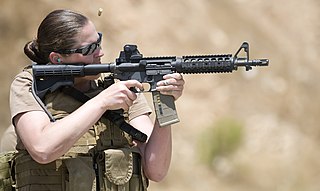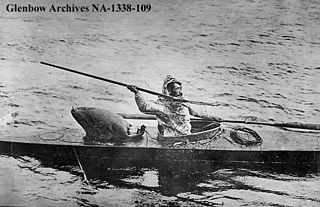 W
WA ranged weapon is any weapon that can engage targets beyond hand-to-hand distance, i.e. at distances greater than the physical reach of the user holding the weapon itself. The act of using such a weapon is also known as shooting. It is sometimes also called projectile weapon or missile weapon because it typically works by launching solid projectiles ("missiles"), though technically a fluid-projector and a directed-energy weapon are also ranged weapons. In contrast, a weapon intended to be used in hand-to-hand combat is called a melee weapon.
 W
WAn arrow is a fin-stabilized projectile that is launched via a bow, and usually consists of a long straight stiff shaft with stabilizers called fletchings, as well as a weighty arrowhead attached to the front end, and a slot at the rear end called the nock for engaging the bowstring. The use of bows and arrows by humans predates recorded history and is common to most cultures. A craftsman who makes arrows is a fletcher, and one that makes arrowheads is an arrowsmith.
 W
WThe ballista, plural ballistae, sometimes called bolt thrower, was an ancient missile weapon that launched either bolts or stones at a distant target.
 W
WA ballistic knife is a knife with a detachable blade that can be ejected to a distance of several yards by pressing a trigger or operating a lever or switch on the handle. Spring-powered ballistic knives first appeared in books and press reports on Soviet and Eastern Bloc armed forces in the late 1970s. Commercially-produced ballistic knives briefly gained notoriety in the United States in the mid-1980s after they were marketed and sold in the United States and other Western countries. Since then, the marketing and sale of ballistic knives to civilians has been restricted or prohibited by law in several nations.
 W
WBedil is a term from Nusantara area of Maritime Southeast Asia which refers to various type of firearms and gunpowder weapon, from small matchlock pistol to large siege guns. The term bedil comes from wedil and wediluppu in Tamil language. In its original form, these words refer to gunpowder blast and saltpeter, respectively. But after being absorbed into bedil in Malay language, and in a number of other cultures in the archipelago, that Tamil vocabulary is used to refer to all types of weapons that use gunpowder. In Javanese and Balinese the term bedil and bedhil is known, in Sundanese the term is bedil, in Batak it is known as bodil, in Makasarese, badili, in Buginese, balili, in Dayak language, badil, in Tagalog, baril, in Bisayan, bádil, in Bikol languages, badil, and Malay people call it badel or bedil.
 W
WA Bulgarian umbrella is an umbrella with a hidden pneumatic mechanism which injects a small poisonous pellet containing ricin. It has a hollowed stalk in which the pellet neatly sits.
 W
WA catapult is a ballistic device used to launch a projectile a great distance without the aid of gunpowder or other propellants – particularly various types of ancient and medieval siege engines. A catapult uses the sudden release of stored potential energy to propel its payload. Most convert tension or torsion energy that was more slowly and manually built up within the device before release, via springs, bows, twisted rope, elastic, or any of numerous other materials and mechanisms. The counterweight trebuchet is a type of catapult that uses gravity.
 W
WA firearm is any type of gun designed to be readily carried and used by an individual. The term is legally defined further in different countries.
 W
WA gun is a ranged weapon designed to use a shooting tube to launch typically solid projectiles, but can also project pressurized liquid, gas or even charged particles. Solid projectiles may be free-flying or tethered. A large-caliber gun is also referred to as a cannon.
 W
WA gun turret is a mounting platform from which weapons can be fired that affords protection, visibility and ability to turn and aim. A modern gun turret is generally a rotatable weapon mount that houses the crew or mechanism of a projectile-firing weapon and at the same time lets the weapon be aimed and fired in some degree of azimuth and elevation.
 W
WA harpoon is a long spear-like instrument used in fishing, whaling, sealing, and other marine hunting to catch large fish or marine mammals such as whales. It accomplishes this task by impaling the target animal and securing it with barb or toggling claws, allowing the fishermen to use a rope or chain attached to the projectile to catch the animal. A harpoon can also be used as a weapon.
 W
WThe Arbalète sauterelle type A, or simply Sauterelle, was a bomb-throwing crossbow used by French and British forces on the Western Front during World War I. It was designed to throw a hand grenade in a high trajectory into enemy trenches. It was initially dismissed by the French Army but General Henri Berthelot thought it had practical value.
 W
WShooting is the act or process of discharging a projectile from a ranged weapon. Even the acts of launching flame, artillery, darts, harpoons, grenades, rockets and guided missiles can be considered acts of shooting. When using a firearm, the act of shooting is often called firing as it involves initiating a combustion (deflagration) of chemical propellants.
 W
WShooting sports is a collective group of competitive and recreational sporting activities involving proficiency tests of accuracy, precision and speed in shooting — the art of using various types of ranged firearms, mainly referring to man-portable guns and bows/crossbows.
 W
WA sling is a projectile weapon typically used to throw a blunt projectile such as a stone, clay, or lead "sling-bullet". It is also known as the shepherd's sling. Someone who specialises in using slings is called a slinger. It was known in ancient China as the Piao Shih.
 W
WThe West Spring Gun was a bomb-throwing catapult used by British, Canadian and Australian forces during World War I. It was designed to throw a hand grenade in a high trajectory into enemy trenches.